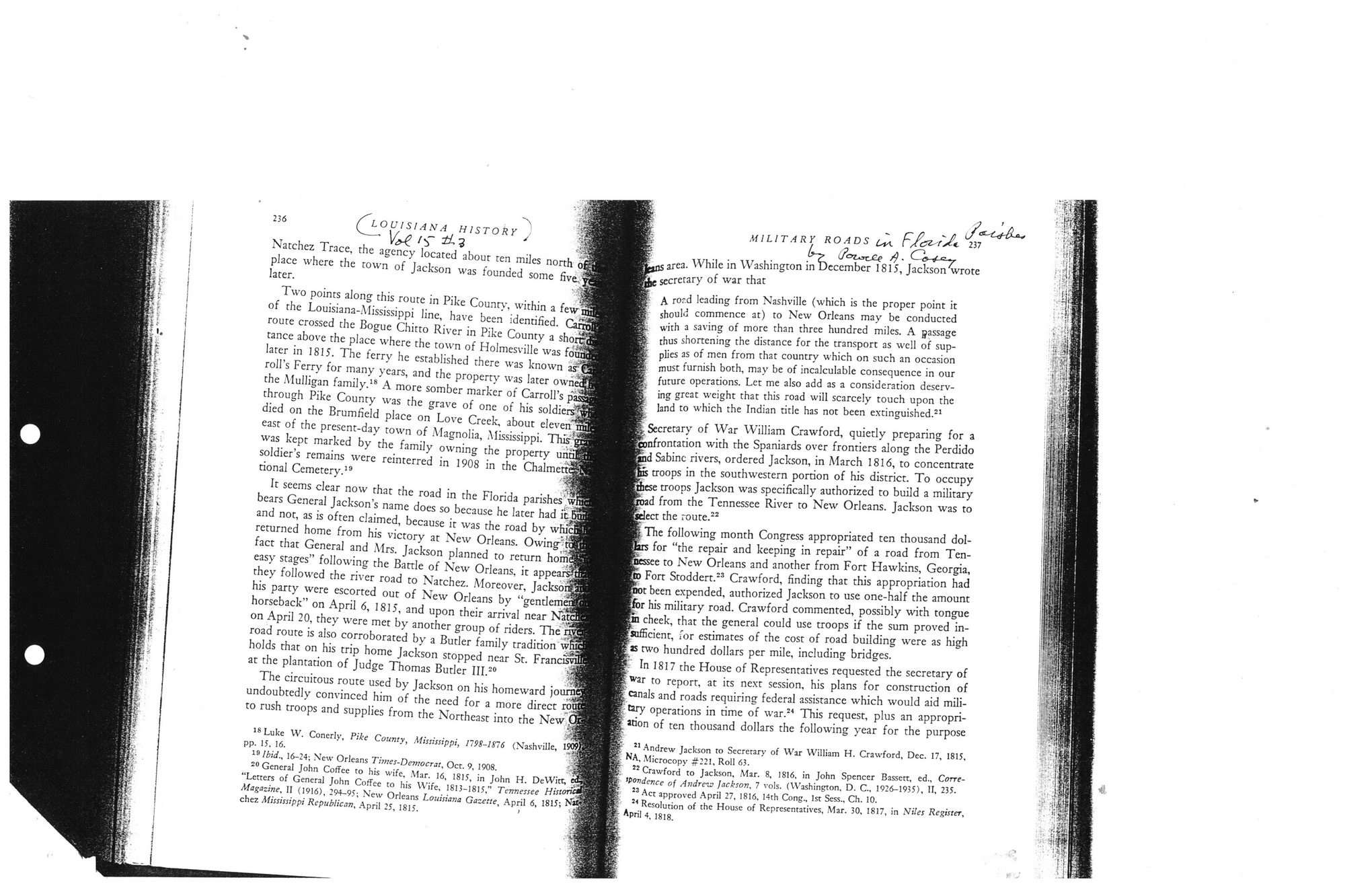This text was obtained via automated optical character recognition.
It has not been edited and may therefore contain several errors.
236 LOUISIANA HISTORY ") ----- t-T ^ 3 Natchez Trace, rhe agency located about ten miles north o' place where the town of Jackson was founded some five/ later. • '> Two points along this route in Pike County', within a few' of rhe Louisiana-Alississippi line, have been identified. Caif route crossed the Bogue Chitto River in Pike County a shortf tance above the place where the town of Holmesville was fdu later in 1815. The ferry he established there was known asf* roll’s Ferry for many years, and the property was later owne the Mulligan family.18 A more somber marker of Carroll’s jv through Pike County was the grave of one of his soldier# died on the Brumfield place on Love Creek, about eleven" east of the present-day town of .Magnolia, Mississippi. This^ was kept marked by the family owning the property un soldier’s remains were reinterred in 1908 in the Chalmett tional Cemetery.19 \ It seems clear now that the road in the Florida parishes*^ bears General Jackson’s name does so because he later had it _ and not, as is often claimed, because it was the road by whic • i- returned home from his victory at New Orleans. Owing"'-fact that General and Mrs. Jackson planned to return hom^ easy stages” following the Battle of New Orleans, it appear", they followed the river road to Natchez. Moreover, Jackso^ his party were escorted out of New Orleans by “gentlerne horseback” on April 6, 1815, and upon their arrival near Nat. on April 20, they were met by another group of riders. Thejij road route is also corroborated by a Butler family traditionv'w_ holds that on his trip home Jackson stopped near St. Franc" at the plantation of Judge Thomas Butler III.20 The circuitous route used by Jackson on his homeward journ undoubtedly convinced him of the need for a more direct ro, to rush troops and supplies from the Northeast into the Newj 18 Luke W. Conerly, Pike County, Mississippi, 1198-1816 (Nashville, 1909 pp. 15, 16. 19 Ibid., 16-24; New Orleans Tbnes-Democrat, Oct. 9, 1908. * 20 General John Coffee to his wife, Mar. 16, 1815, in John H. DeWitt, ^ “Letters of General John Coffee to his Wife, 1815-1815,” Tennessee Histon Magazine, II (1916), 294-95; New Orleans Louisiana Gazette, April 6, 1815; chez Mississippi Republican, April 25, 1815. ' MILITARY ROADS u*. 237 (?oi*xxJZ-e $ • Gs-J area- While in Washington in December 1815, Jackson wrote jjg secretary of war that a ror.d leading from Nashville (which is the proper point it should commence at) to New Orleans may be conducted with a saving of more than three hundred miles. A passage thus shortening the distance for the transport as well of supplies as of men from that country which on such an occasion must furnish both, may be of incalculable consequence in our future operations. Let me also add as a consideration deserv-~ ing great weight that this road will scarcely touch upon the land to which the Indian title has not been extinguished.21 Secretary of War William Crawford, quietly preparing for a nfrontation with the Spaniards over frontiers along the Perdido d Sabine rivers, ordered Jackson, in March 1816, to concentrate r- troops in the southwestern portion of his district. To occupy ese troops Jackson was specifically authorized to build a military «ad from the Tennessee River to New Orleans. Jackson was to Select the route.22 The following month Congress appropriated ten thousand dol-ns for “the repair and keeping in repair” of a road from Tennessee to New Orleans and another from Fort Hawkins, Georgia, id Fort Stoddert.23 Crawford, finding that this appropriation had t been expended, authorized Jackson to use one-half the amount for his military road. Crawford commented, possibly with tongue cheek, that the general could use troops if the sum proved insufficient, for estimates of the cost of road building were as high as two hundred dollars per mile, including bridges. In 1817 the House of Representatives requested the secretary of war to report, at its next session, his plans for construction of canals and roads requiring federal assistance which would aid military operations in time of war.24 This request, plus an appropriation of ten thousand dollars the following year for the purpose 11 Andrew Jackson ro Secretary of War William H. Crawford, Dec. 17, 1815, ^A, Microcopy #221, Roll 63. 22 Crawford to Jackson, Mar. 8, 1816, in John Spencer Bassett, ed., Corre-tyondence of Andrew Jackson, 7 vols. (Washington, D. C-, 1926-1935), II, 235. 23 Act approved April 27, 1816, 14th Cong., 1st Sess., Ch. 10. 54 Resolution of the House of Representatives, Mar. 30, 1817, in Niles Register, April 4, 1818.

Old Spanish Trail Document (074)